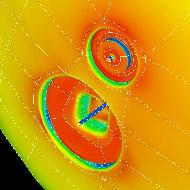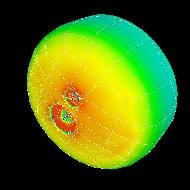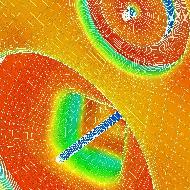_____ Computational Fluid Dynamics _____
CFD Simulations for the Huygens-Cassini Probe
Roy Williams
Caltech CACR
Jochem Hauser, Ralf Winkelmann
Center for Logistics and Expert Systems, Germany
Hans-Georg Paap
Genias GmbH, Regensberg, Germany
Martin Spel, Jean Muylaert,
ESTEC, Noordwijk, Netherlands

In 2004, after a journey of seven years past Venus and Jupiter, the Cassini spacecraft will reach the vicinity of Saturn.
Piggybacked on this NASA vehicle is the European Huygens probe, which willdrop into the atmosphere of Saturn's largest
moon, Titan. During the three-hour descent, delicate instruments will emerge from the bow surface to measure the atmospheric
composition and to take pictures of the surface. Titan is especially interesting because its atmosphere contains complex
hydrocarbons reminiscent of the paleoatmosphere of Earth where life began.
The objective of this simulation is to gauge the effects of any dust that might be suspended in the Titanian atmosphere: an
instrument could be jeopardized if significantly impacted by high-speed particles. We shall use streamlines to determine
whether the instrument lenses get a larger or smaller dust impact rate compared with other parts of the craft. Some initial
results are shown in Figures 1-3, computed on 128 nodes of the Caltech Paragon.

|

|

|
|
Figure 1
|
Figure 2
|
Figure 3
|
Figures 1-3. The
Huygens-Cassini spacecraft as it enters the nitrogen-methane atmosphere of Saturn's largest moon,
Titan. We see the bow face of the craft. Figures 1-3
show increasing magnification of the delicate instruments that
measure atmospheric properties during the subsonic descent. In this Euler
flow simulation, computed on 128 nodes of the
CSCC Intel Paragon, color represents increasing temperature from blue to red. The white lines in the first two panels are
boundaries of the 462-block 3D grid. In the last panel, the surface grid is shown. A major question is the effect of the impact
of suspended dust on the instruments.
We are using a compressible Navier-Stokes code, Parnss, which is designed to simulate flows in the hypersonic to
subsonic range, with complex geometry and real-gas effects. Parnss has been used to evaluate flow around the Shuttle
and the European Hermes spaceplane, as well as for calibration of hypersonic wind tunnels.
Parnss uses a multiblock grid that may, for a complex geometry, have hundreds of blocks, each of which may have a
1,000,000-to-one thickness-to-width ratio in the grid in which boundary layers must be resolved. We may wish the solver to
converge to a steady state, or the solver may be run in the time-accurate mode.
The solver approaches the steady state in three stages: first an explicit scheme for efficient treatment of transients, followed by a
block-implicit scheme for faster convergence of the shock position, with a final Newton solver to converge quadratically to the
steady state. We are evaluating criteria for the automatic transition between these phases, to obtain maximum computational
efficiency with minimum human interaction. For time-accurate flow modeling, the objective is to see a time history of the flow,
rather than just a single steady state, so that I/O, storage, and visualization subsystems are the primary bottlenecks on the
computation.
With Ronald D. Henderson of Caltech, we have recently implemented a new output path to enable real-time visualization of the
behavior of the solver. Each processor of the Paragon outputs its data to a HIPPI node, where it is sent through the Caltech
HIPPI fabric to a Silicon Graphics workstation that is displaying the current flow, using the visualization code Visual3 from
MIT. Only a small part--presumably the interesting part--of the entire simulation data need be sent to the Visual3 server. This
output path reduces the need for storage, transfer, and postprocessing of large data files, with the beneficial side-effect of
making it much easier to apprehend the behavior of the simulation, whether it is the convergence history for the steady-state
case or the flow itself in the time-accurate case.
Last Modified: March 4, 1996 (jlj)
Available through: Annual Report 1995 (page 56-57), Concurrent Supercomputing
Consortium, California Institute of Technology, USA and
http://www.cacr.caltech.edu/publications/annreps/annrep95/cfd1.html


